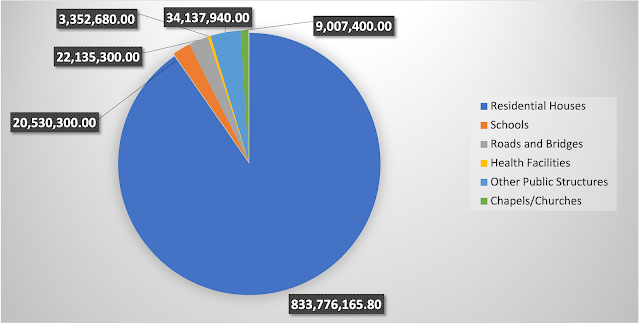 |
| Damage of Typhoon Odette to Basic Infrastructure in Candijay, Bohol (Source: Jean Celeste Paredes, based on Candijay MDRRMO's RDANA) |
To rebuild the infrastructure of the town of Candijay in Bohol, the Philippines, back to its situation before Typhoon Odette, it needs a whopping 922 million Philippine pesos. Ninety percent (90%) of that requirement is for the reconstruction of 6,924 houses, 16% of which are totally damaged. Candijay is home to 33,699 people living in totally or partially damaged houses.
The typhoon did not spare basic infrastructures. Total damages estimated in schools amounted to Php20 million and in basic health facilities as clinics up to Php3.3 million. Damages in churches and chapels were estimated at Php9 million, while in other public infrastructures, as barangay halls and covered courts, it was estimated at Php34 million. Also, total damages to roads nd bridges were estimated at Php22 million pesos.
Density of Affected Families, Municipality of Candijay (Source: Engr. Mark Russel Guatno based on Candijay MDRRMO data)
Across barangays, Poblacion sustained the most significant damage at Php164 million, followed by Cogtong at 99 million, and Can-olin at 74 million. These barangays are the town’s most densely populated areas, registering the highest number of damages in dwellings. Cogtong is located along the coast, exposed to stronger wind and very susceptible to flooding, creating an environment of multi-hazard because of fast-moving air, water, and debris.
All these data are based on the Rapid Damage Assessment and Needs Analysis (RDANA) prepared by the Municipal Disaster Risk Reduction and Management Office of Candijay as of 6 January 2022. Among the towns in Bohol, only Candijay was able to submit this level of granularity in terms of data. Data such as this is crucial not only in planning relief efforts but also in forecasting reconstruction efforts. The submitted report even shows the priority needs of the town, including food packs, water latrines and hygiene kits, temporary shelter materials, housing assistance, and engineering interventions to clear impassable roads. Based on our data so far, only food packs were distributed in the area.
The role of local government units in disaster relief operations and post-disaster reconstruction is critical and important. The assessment of the magnitude of the disaster and its impact on people and their coping capacity is a task that local government units as first responders can do. The collection and aggregation of data and its updating on a regular basis is crucial to ensure that what donor organizations and communities bring to the area are relevant to the needs of people and the overall priorities of the community.
What Candijay’s MDRRMO did is commendable. They started collecting data a day after the typhoon and have progressively conducted fieldwork until they had covered the whole town. The succeeding assessment of the typhoon's damage on people’s livelihoods and livelihood assets is also crucial as the town charts its economic recovery plan. All these efforts are crucial to ensure that agencies and philanthropists can channel resources to initiatives that are most relevant to people’s pressing needs.

Comments